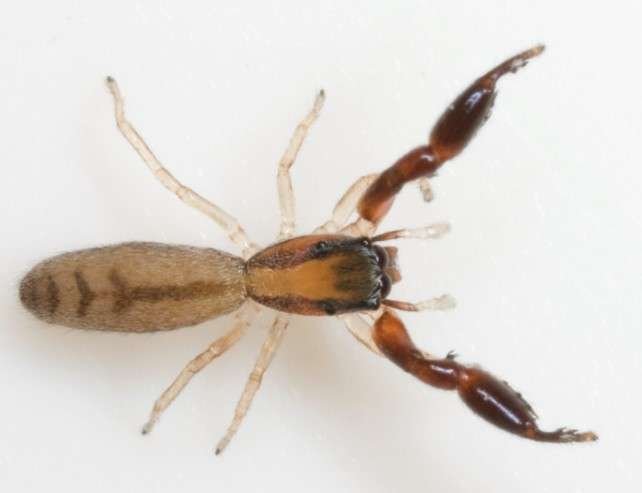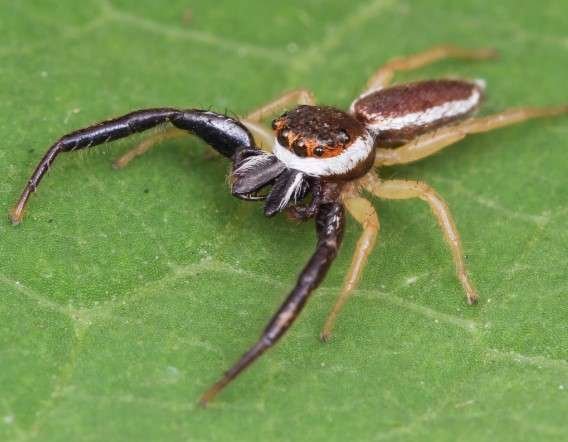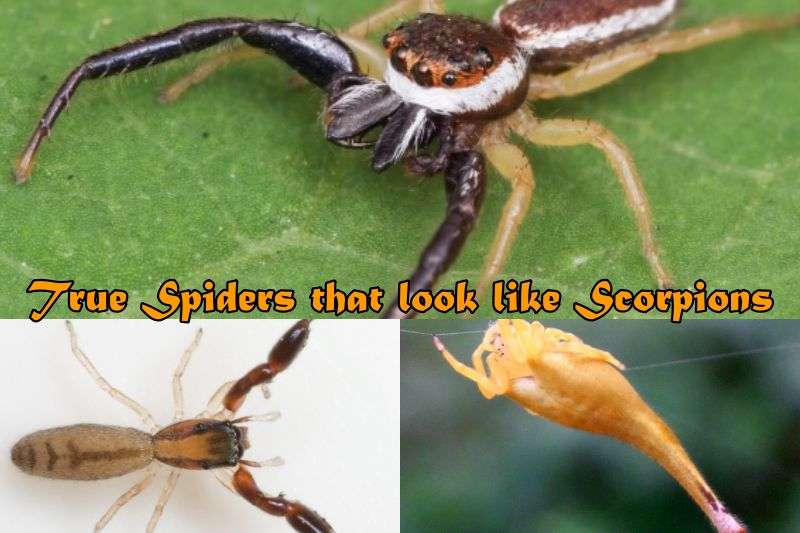Mimicry is quite a common phenomenon among insects. Often, an organism mimics another organism which may or may not is related, to reap the benefits of the latter’s behavior or appearance.
When an organism mimics another species, it does it for two primary reasons: food and protection. In most cases, the species that is mimicked holds a higher ecological position, mostly in terms of strength.
Mimicking such an organism may deceive the predators, or getting food might become easy. For a variety of reasons, certain spiders are known to imitate insects like ants.
Crab spiders are a common name for some other spiders that resemble crabs and are skilled camouflage agents. But they do not stop there. Many spider species try to look like their distant cousins, the scorpions. In today’s article, we are going to talk about Spiders that look like Scorpions.
6+ True Spiders that look like Scorpions
1. Indopadilla insularis
The first spider in this list of Spiders that look like Scorpions, we have the Indopadilla insulris. This spider species is one of the most recent inclusions to the World Spider Catalogue, as the genus Indopadilla had its first discovery in 2019.
Since the Indopalia insulris bears a very close resemblance to the Bavia kairali or Bavia insulris, many researchers believe it to be a subspecies.
Discovered in India, these species show one of the finest scorpion mimicries in the entire Spider family. This genus is a relatively discovery, and there has been very little work on their taxonomic positioning.
A similar species, the Indopadilla darjeeling, sharing its name with the famous hill station in India, Darjeeling also deserves to be on this list. Both these Indopdilla species share many similarities and also with the Genus Bavia.
They have a flat and broad carapace, along with a tube-like abdomen that resembles the tail of a scorpion. The first pair of legs are enlarged, and protrude out quite like the pincers of a scorpion.
- Size: about 6-8 mm
- Geographic location: India
2. Arachnura
The Genus Arachnura consists of multiple species, having one common feature, which is, they all are Spiders that look like Scorpions. Having the name Drag-tailed Spider, or Scorpion-tailed Spider, they are some of the finest scorpion mimicries.
Unlike the Indopadilla, which bears characteristic enlarged forelegs like scorpions’ pincers, the mimicking feature here is the tail. Many species show other forms of mimicry like having the appearance of a dead leaf, twigs, etc.
-
Arachnura higginsi

Individual body colors can range from cream to brown to sometimes even black, sometimes with a distinct patch of yellow or red over the abdomen.
Only females have tails, and they get longer with every molt. Although the tail resembles that of a scorpion, somewhat, it lacks a stinger. The spider poses no danger to humans.
- Common name: scorpion-tailed spider
- Size: 16 mm (females), 2 mm (males)
- Geographic location: Australia
-
Arachnura melanura

With only three to four spotting to date, the Arachnura melanura is a relatively untouched species. The body coloration is primarily brown. A light brown median band dorsally runs from the two shoulder horns to the end of the abdomen.
- Common name: black tail spider
- Size: 17 mm (females), 3 mm (males)
- Geographic location: India, Japan, etc
3. Cheliferoides longimanus

Mimicry can be in two forms, either morphological or behavioral. However, what Cheliferoides longimanus exhibits are strictly morphological mimicry. The front pair of legs are dark in color, and robust, nearing stark similarities with those of a scorpion.
They even have sharp edges, to give them a claw-like appearance. Cheliferoides longimanus is a jumping spider species, with legs light brown. The abdomen has a central marking with brown over a lighter color, while the thorax bears a dual tone.
- Geographic location: the USA
4. Hentz Jumping Spider

The Salticidae family, whose tiny members are adept at leaping, includes the Hentz Jumping Spider. Jump is the Latin word “saltare.” Neither of the jumping spiders is particularly enormous, including this one.
In an ambush strike, this spider directly pounces on its prey instead of weaving silk webs to capture it. Its first set of legs is larger and longer than the other pair of yellow legs.
These powerful legs aid in bringing insects under control so the spider may bite them and inject their venom. Subtle dark lines can be seen crossing the abdomen, and the top of the cephalothorax has a mottling of dark and white colorations.
- Scientific name: Hentzia palmarum
- Geographic location: North America, Cuba, Bahamas, etc.
5. Stagetillus opaciceps
Next up, we have a Southeast species of Jumping Spiders, the Stagetillus opaciceps. A bright yellowish-red color with two dark side stripes characterizes the carapace.
Dark purple with long white marks on the margins and a transverse white mark close to the spinnerets, and a very slender and elongated abdomen.
All legs, but the first pair, are yellow. The front pair of legs is quite robust, and protrudes front, mimicking the claws or pincers of a scorpion.
- Size: 6 mm (females), 8 mm (males)
- Geographic location: Endemic to Malaysia and Indonesia
6. Dwarf Florida Jumping Spider
The last spider in this list of spiders that look like scorpions is the Dwarf Florida Jumping Spider. Biologists consider this species to be strictly native to the USA, as spotting occurred in only a few states like Arizona, Georgia, Texas, Louisiana, Mississippi, etc.
This species has brown legs, except the front pair of legs, which is enlarged quite like that of a scorpion. The thorax and head are black in color, with certain white markings on the edges.
The abdomen is long, and along with its front legs, we can say that this species mimics the scorpion.
- Scientific name: Metacyrba floridana
- Geographic location: Native to the United States of America
Here, we come to the end of this article, Spiders that look like Scorpions. Do look into our previous article, about Spiders that look like Ants. Hope you will enjoy it. We will be back soon, so until then, goodbye. You can visit our website to read more interesting articles.
References:
Indopadilla, a new jumping spider genus from India- by Pradeep M. Sankaran et al.
Insectidentification- Hentz Jumping Spider
Also Read:

A zoology student turned writer. Nature has always been a magnet to me, and to unearth some of its secrets through my articles is my prime intention. If not engaging myself with nature and anime content, you can always find me going through some Bengali classics or filling the air with some soulful Tabla beats. An artist, trying to throw some colors to my blank canvas of life.
